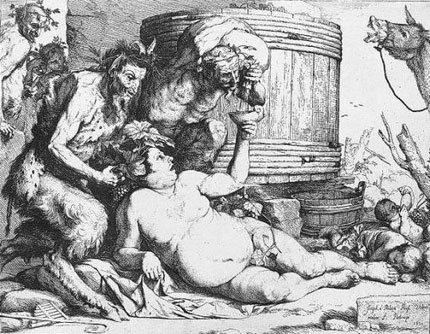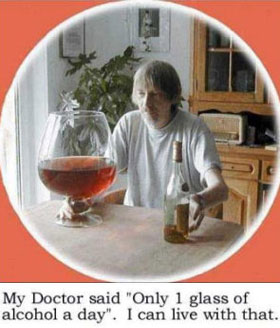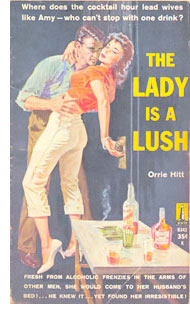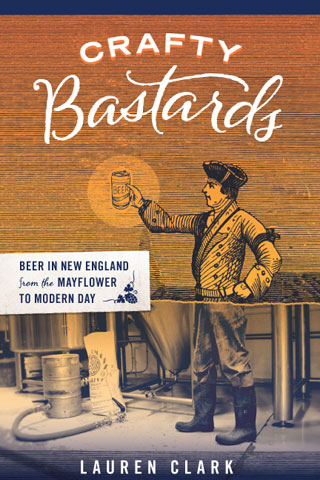Posts Tagged ‘alcohol’
February 14th, 2010

A fellow drinker said recently, “I just discovered you should never input your drinks into a calorie-counter app. No wonder I look like Santa Claus.”
Boozing makes you fat, right? Yes. No. Maybe. When it comes to alcohol and body weight, things get weird. That’s according to the scientific and medical literature out there on the web — a confusing hodgepodge of sites looking at alcohol consumption mostly from fitness, diet or addiction perspectives, or sites representing incompatible agendas, i.e. MADD vs the Distilled Spirits Council of the United States, or the NIH vs the BATF. Of course, there are plenty of dense scientific articles on PubMed, but making sense of those and coming to any useful, real-world conclusions is a task I would only undertake for a lot of money.
In a way, it seems simple: alcohol has calories, and if you consume too many calories without burning them, you’ll gain weight. It’s funny how many people don’t realize that alcohol itself, aside from sugary mixers or carbs in beer, is calorie-rich. In fact, pure ethanol has 7 calories per gram compared to 4 for carbs and protein and 9 for fat. Of course, we don’t drink pure ethanol; we drink drinks. So here are some more relevant numbers based on the caloric content of various alcoholic beverages (according to CalorieKing) and recipes that represent the sort of cocktails that drinkbostonians are likely to consume.
- Fort Point (among the many “Manhattan variations” out there): 2 oz rye whiskey, 1/2 oz Punt E Mes, 1/4 oz Benedictine: 174 calories.
- Margarita: 2 oz tequila, 1 oz Cointreau, 3/4 oz lime juice: 223 calories.
- Martini: 2 oz gin, 1 oz vermouth: 173 calories.
- Gin and tonic: 143 calories.
Now, for comparison’s sake …
- Coca Cola (12 oz): 143 calories.
- Narragansett (12 oz): 152 calories.
- Sierra Nevada Bigfoot Barleywine (12 oz, 10% abv): 330 calories.
- Red or white Wine (5 oz): roughly 120-130 calories.
So, if you take the generic, 2,000-calorie daily intake on which standard nutrition labels are based, and you add up the two Fort Points, three glasses of wine, and beer nightcap you might consume on a night off — roughly 875 calories — you have 1125 calories left for food if you want to avoid gaining weight. Which means eating like a supermodel without any of the financial benefits. Depressed yet?
But wait. “Scientists have not been able to tie alcohol consumption consistently to weight gain,” according to this article on ShapeFit. Huh? It continues, “Researchers have also found that heavy drinking reduces body fat, but still others point to evidence that it raises the risk of becoming overweight or obese. There may never be a simple answer, since there are so many variables.”
Oh, those pesky variables. You’ve got to, for instance, stack up your eating patterns against your drinking patterns. Do you tend to eat — and eat a little more than you normally would — whenever you go out drinking? Or does your boozing often replace food and other types of caloric beverages? Also: Are you genetically programmed to be an alcohol-metabolizing machine? And perhaps the peskiest variable of all explaining why there “may never be a simple answer” to what role alcohol plays in weight gain: “People in studies are prone to under-report how much they drink, rendering many findings unreliable.”
Ah, yes. Under-reporting one’s booze intake is a rich, American tradition. It’s not surprising, given that our official definition of “drinking in moderation” is one drink per day for women, two for men. That’s not moderate, that’s puritanical. It’s like when nutritionists say that a serving of meat should be no bigger than a deck of cards. Oh, I guess that means I’m splitting this porterhouse steak with my date, plus the family of four sitting next to us.
My advice? Ditch the calorie-counting app, get some exercise, and pick up the recently reissued Drinking Man’s Diet, originally published in 1964. The guy who wrote it, Robert Cameron, died slender last year at age 98.
Tags: alcohol, calories, health, weight gain
Posted in Books & resources | 8 Comments »
June 20th, 2009
 » As I prepare to make my third annual trip to New Orleans for Tales of the Cocktail, two New York Times articles this week combined in my head to form a timely and contradictory message: “Booze is bad for you. New Orleans is good for you.” The first article, Alcohol’s Good for You? Some Scientists Doubt It, looks skeptically at studies that show health benefits from moderate drinking. The takeaway is this: “It may be that moderate drinking is just something healthy people tend to do, not something that makes people healthy.” If you’re reading this, I’m guessing you figured that out a long time ago. I’m guessing that, even if you are a moderate drinker (one drink per day for women, two for men), you aren’t drinking for your health, but because it’s fun. Imagine — doing something that confers no benefit other than fun!
» As I prepare to make my third annual trip to New Orleans for Tales of the Cocktail, two New York Times articles this week combined in my head to form a timely and contradictory message: “Booze is bad for you. New Orleans is good for you.” The first article, Alcohol’s Good for You? Some Scientists Doubt It, looks skeptically at studies that show health benefits from moderate drinking. The takeaway is this: “It may be that moderate drinking is just something healthy people tend to do, not something that makes people healthy.” If you’re reading this, I’m guessing you figured that out a long time ago. I’m guessing that, even if you are a moderate drinker (one drink per day for women, two for men), you aren’t drinking for your health, but because it’s fun. Imagine — doing something that confers no benefit other than fun!
» Which segues perfectly into the second article, The Way of the Bayou, about New Orleanians being completely out of step with “progress” and not fretting about it one bit. “While the rest of us Americans scurry about with a Blackberry in one hand and a to-go cup of coffee in the other in a feverish attempt to pack more achievement into every minute, it’s the New Orleans way to build one’s days around friends, family, music, cooking, processions, and art. For more than two centuries New Orleanians have been guardians of tradition and masters of living in the moment — a lost art.” This is a rosy view of the city, but there’s truth in it. It’s something you pick up on pretty quickly when you’re down there, especially during an event as joyously frivolous — and bad for your health — as Tales of the Cocktail.
» Speaking of Tales, the event culminates in the annual Spirit Awards, which recognize the best bars, bartenders, writers, brand ambassadors, products, etc. in the cocktail world. This year, Drink has been nominated for Best New Cocktail Bar. Cross your fingers and hope for the best, ’cause Gertsen and co. deserve to win.
» Some Boston bar proprietors received a strange promotional item this week: a tasteful looking box with the words “Thanks for nothing” on the outside and an empty bottle of Knob Creek bourbon on the inside. An accompanying letter explains that consumer demand has literally drained the barrels dry, and it thanks the recipient for “helping make it happen.” As Dave Barry would say, I am not making this up. The letter continues, “We ask for your patience and your continued support. We plan to capitalize on this temporary shortage by creating customer communications and conducting outreach that underscore Knob Creek’s commitment to quality. Working together, I’m sure we’ll all be even more popular and profitable once supply is restored.”
Ooooh. Commitment to quality. Working together. Popular and profitable. The boutique bourbon market is wielding some fancy PR! The letter should’ve just said, “If you’re paying $10 more a bottle than you used to for our bourbon, bless your soul. By the time supplies are replenished, your customers will be used to paying the higher price. Genius!”
» And good gawd, y’all, MC Slim JB (food/drink critic and occasional contributor in this space) just posted There’s a riot going on in the cocktail world, an eloquent tribute to and smart summation of the rise of the craft cocktail scene in Boston. If you’re a regular here, a lot of the nuts and bolts of what he’s saying will already sound familiar, but his thoughtful take on things is well worth checking out. As he explains, his food-oriented audience and writing peers are often surprisingly ignorant of what’s been going on for the past several years, drink-wise. It’s time they knew.
Tags: alcohol, health, Knob Creek bourbon, Tales of the Cocktail 2009
Posted in Booze in the news, Boston bars, New Orleans, Nips | 6 Comments »
December 12th, 2008
 Being a drinking woman, I couldn’t help but be intrigued by a pair of recent articles: New York Magazine’s “Gender Bender,” about the rise in heavy drinking among women and possible reasons for it; and Salon’s response, “I’m sooo wasted off feminism,” which takes the NYM article to task for its premise that feminism is worthy of blame for all those messes in dresses running around town. Wow, is there some, um, drink for thought here.
Being a drinking woman, I couldn’t help but be intrigued by a pair of recent articles: New York Magazine’s “Gender Bender,” about the rise in heavy drinking among women and possible reasons for it; and Salon’s response, “I’m sooo wasted off feminism,” which takes the NYM article to task for its premise that feminism is worthy of blame for all those messes in dresses running around town. Wow, is there some, um, drink for thought here.
The NYM article says, “The number of women who identify as moderate-to-heavy drinkers has risen in the last ten years, while the number of women who say they are light drinkers has declined.”
The reasons, according to NYM?
- Feminism: “For the bulk of history, women have skewed toward the teetotaler end of the spectrum; not until the middle of the last century did a burgeoning relationship with alcohol coincide with Second Wave feminism and a general impulse to close the gender gap across the board.”
- Marketing: “Dr. David Jernigan, the executive director of the Center on Alcohol Marketing and Youth, believes that the real onslaught — and its effect on the beverages women consume — didn’t reach critical mass until the turn of this century. New alcopop flavors proliferated, Jell-O shooters showed up in grocery-store aisles, and companies rolled out vodkas in increasingly exotic flavors … ‘There’s a clear effort by the industry to create products for female drinkers. And it has had an effect.'” (A whole new argument against flavored vodka!)
- Higher education: “The transition from high school to college marks the greatest increase in substance abuse among women, and the more educated a woman is, the more likely she will be to drink throughout her life.”
- Third-wave feminism (a.k.a. “Do me” feminism or “Girls Gone Wild” feminism): “And if you choose to drink yourself unconscious in some random guy’s bed, that’s also your prerogative. To say that you shouldn’t would be paternalistic hand-wringing, implying that a woman needs to be protected from herself.”
The Salon response’s major beef is with NYM’s sub-headline asserting that “this is the kind of equality nobody was fighting for.”
Salon retorts, “Wait, it isn’t? Since when was feminism supposed to bring about selective equality, where women get to enjoy the benefits of being a man, but none of the liabilities? If you claim only the good and none of the bad — it isn’t really equality.” Agreed. Women today have every right to avail themselves of the freedom to be both successful investment bankers and drunken dickheads. Oh, and the connection between higher ed and alcoholism? I guess that means we should be celebrating the fact that, as NYM reports, men are both attending college in fewer numbers and “reining in their drinking.”
The thing that gets me is the way in which only the extreme ends of certain behaviors are portrayed in the media. The NYM piece begins with an anecdote about a twenty-something investment banker who downs as many as 24 drinks in 24 hours, and it ends with the director of the National Center on Addiction and Substance Abuse at Columbia University advising women to stick with the “federally recommended maximum of one drink a day.”
As I wondered in my own take on such matters, “Is there any way a girl can occupy some median point on the scale between ‘drinks a little Chardonnay on the weekends’ and ‘brings a flask to the office?'”
Tags: alcohol, binge-drinking, feminism, women
Posted in Booze in the news | 5 Comments »

 » As I prepare to make my third annual trip to New Orleans for
» As I prepare to make my third annual trip to New Orleans for 
